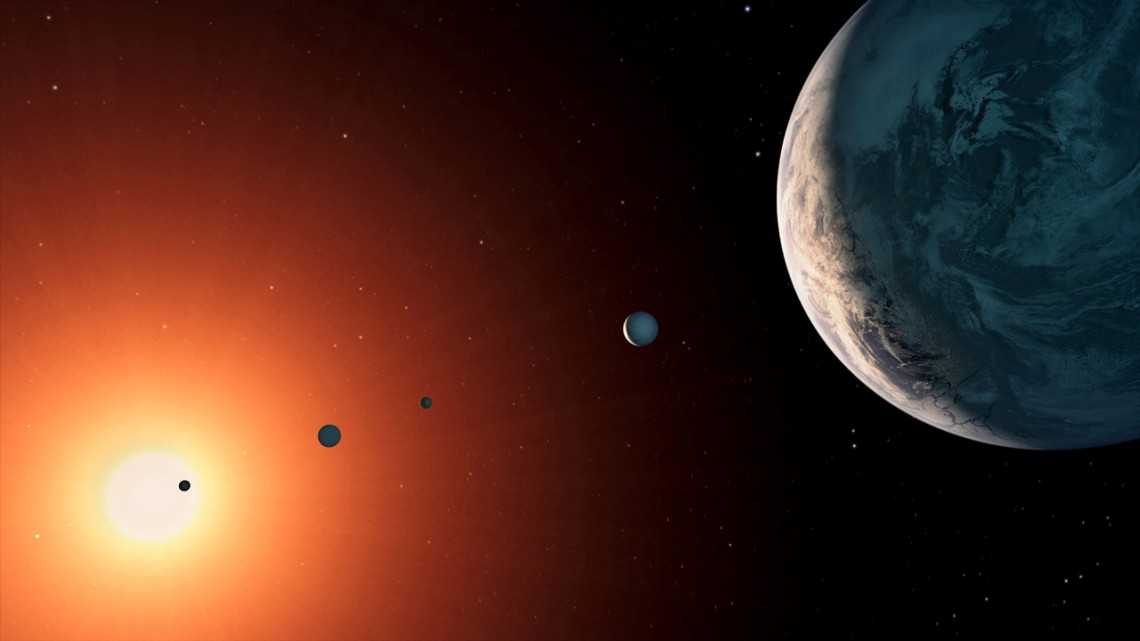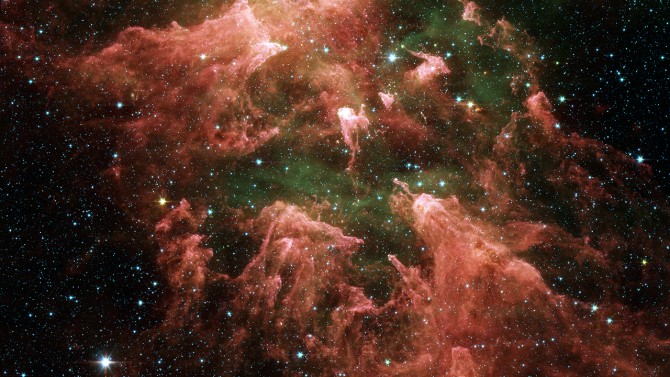
In this artistic rendering, seven Earth-sized planets were discovered all at once at the TRAPPIST-1 star, which is an ultra-cool dwarf, thanks to the Spitzer Space Telescope. NASA announced the important discovery in February 2017, as each planet may have liquid water – a key to life.
After dust-busting the cosmos, Spitzer telescope’s mission ends
By Blaine Friedlander
The Spitzer Space Telescope – with its Cornell-developed infrared spectrograph instrument – has been peering through murky cosmic dust to study the distant heavens for 16 years. Originally scheduled to last 2.5 years, the mission officially will end Jan. 30.
Spitzer was the final mission of NASA’s Great Observatories program. The infrared spectrograph portion of the mission ended in 2010.
“For many of us in the astronomy community, saying goodbye to Spitzer is saying goodbye to a dear friend that journeyed with us through the cosmos,” said Nikole Lewis, assistant professor of astronomy and deputy director of Cornell’s Carl Sagan Institute. She served on NASA’s Spitzer user panel from 2012-16 and on the Spitzer oversight committee since 2016.
“Spitzer has spawned an entire generation of scientists, now eagerly awaiting the launch of the James Webb Space Telescope to continue exploring the infrared universe,” Lewis said.
In 1998, NASA and the Jet Propulsion Laboratory (JPL) awarded Cornell the contract to design the infrared spectrograph instrument on the Space Infrared Telescope Facility (SIRTF) – the Spitzer telescope’s original name – and the space agency concurrently named James Houck, professor of astronomy, as the instrument’s principal investigator. Houck died in 2015. The infrared spectrograph was built by Ball Aerospace, based on the Cornell designs and prototypes.
Houck’s connection to the program dated back to the 1970s, when the spacecraft was first proposed. He led a team in 1984 to design it; by the late 1990s, about eight Cornellians were involved with the design and around 15 Cornellians were involved during the flight phase.
George Gull, a research support specialist who was part of the telescope project from 1987-98, before it was formally named, said the original telescope faced budget constraints, and the design had many moving parts that rotated and slid. “Moving parts add to the chance of failure,” he said.
Houck designed a more-simple instrument without moving parts, which was less expensive, that eventually became the final infrared spectrograph instrument.
The SIRTF craft was launched in August 2003 from Cape Canaveral, Florida. By December 2003, the then-renamed Spitzer telescope was yielding strong science.
A few months after the launch, senior research associate Henrik Spoon arrived from the Netherlands as a Cornell Spitzer Fellow, to analyze and scientifically report the instrument’s mid-infrared spectroscopic observations of colliding galaxies. These merging galaxies become incredibly bright in the infrared.
“They are beautiful collisions that happen in super-slow motion,” Spoon said. “It takes a billion years for such a collision to completely unfold.”
In 2014, Dominik Riechers, assistant professor of astronomy, found spectral fingerprints relating to galactic composition, in a very distant galaxy, after combing through infrared spectrograph data. One important bit of data he found resulted from photons emitted when polycyclic aromatic hydrocarbon (PAH) molecules vibrate.
Such emissions occur when newly formed stars illuminate their natal clouds and the PAH molecules inside them. The galaxy is more than 125 billion light years away. The detected emission was released only 1.5 billion years after the Big Bang, said Riechers. With the telescope, astronomers had to stare at the signal for 24 hours in order to detect it.
“Jim [Houck] would never have dreamed to be able to use the infrared spectrograph to detect these spectral fingerprints of star formation in such a distant galaxy,” Riechers said, “but we did.”
According to the JPL, Spitzer’s greatest discoveries included the detection of fullerenes – more commonly known as “buckyballs” – which are soccer ball-shaped carbon structures long thought to be features of interstellar space but never before observed. The detected buckyballs were found in a planetary nebula called Tc 1 and reported in the journal Science in 2010.
In 2005, the Spitzer mission was the first telescope to directly observe light from an exoplanet, a planet outside of our solar system, which inaugurated a new era in exoplanet exploration, according to the JPL.
In May 2009, Spitzer scientists produced the first “weather map” of an exoplanet, HD 189733b, which charted surface temperature variations and revealed that roaring winds whip through the planet’s atmosphere.
“Although exoplanet science was not originally envisioned as a science case for Spitzer,” Lewis said, “ingenious use of the telescope captured some of the first drops of light from these distant worlds, allowing for the detailed exploration of hundreds of planetary systems beyond our own.”
By looking in the infrared – below the red end of the visible spectrum – Spitzer sees what optical telescopes like Hubble cannot. Even though it is cosmically turbid, dust transmits infrared starlight but absorbs visible starlight. The absorption heats the dust, where it glows in the infrared. Even where dust is thin, cooler objects such as exoplanets shine through in the infrared.
“Spitzer does things that were simply impossible before,” said former Cornell research associate Vassilis Charmandaris, now professor of physics at the University of Crete, in 2007. “It did more than improve on previous infrared telescopes: It opened something completely new, similar to what the rovers did for Mars.”
Said Greg Sloan, a former Cornell astronomy research associate, in 2007: “Without Spitzer, we would have a much less complete understanding of the infrared universe, which means a much less complete understanding of dust.” He is now with the Space Telescope Science Institute and a fellow at the Carl Sagan Institute.
“Dust acts as a repository for heavier elements and allows processes that can’t occur with gas alone,” Sloan said. “It was dust grains that first accreted into planets: no dust, no Earth; no Earth, no life. The dust is pretty important.”
Said Lewis: “Spitzer has laid the foundation for exoplanet exploration for the coming decade and beyond.”
Media Contact
Get Cornell news delivered right to your inbox.
Subscribe

